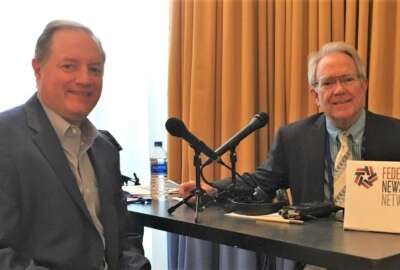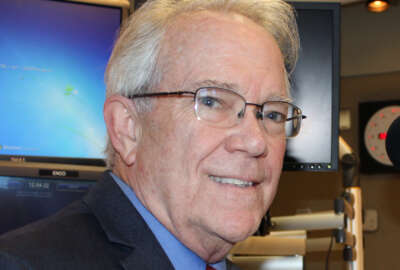
Ann Dunkin: From schools to EPA to county gov’t
Ann Dunkin's career included CIO positions at Palo Alto school district, Environmental Protection Agency and Santa Clara County, California.
If I’ve learned anything this last year at Federal News Network interviewing scores of state and local government chief information officers from across the country, it’s the tortuous paths most of these individuals have traveled prior to their government appointments.
Delaware CIO James Collins was a dental technician in the Air Force. John McMillan in Pennsylvania was in tech support at the Department of National Defense in Canada. And my favorite story involves my old stomping grounds in Massachusetts, where my successor as CIO several times over, Curt Wood, tells us he began his career in state prison; not as a prisoner, but as a correctional officer. So it’s all over the place.
On the surface it may appear that Ann Dunkin, who just resigned as CIO of Santa Clara County, California, last month may be an exception to this pattern. She started the next stage of her heretofore successful career at Dell this week.

Her Santa Clara appointment in 2017 was in fact preceded by her stint as CIO for the Environmental Protection Agency beginning in 2014. This CIO route between government sectors has become more frequent in the last two decades as we’ve seen more and more instances of state and local IT leaders becoming CIOs in charge of IT in federal agencies. There have likewise been instances of federal CIOs, like Dunkin, taking over those roles at the state level, and at the local government level as well. However, what is unique in Dunkin’s case is the fact that she was the CIO for the Palo Alto School District before she made the trip to the Federal Triangle and EPA headquarters — not exactly a lateral move. Both the distance between job sites and the attending responsibilities were quite significant.
School district provided her tech foundation
This reality informed my initial question when I asked Dunkin if her experience as a school district CIO had proven to be beneficial when she took over the reins at EPA.
“That’s really an interesting question and the answer is, ‘yes’,” she said. Dunkin went on to explain that she was not an IT professional by education. She was an industrial engineer designed automated material handling systems for the first part of her career at HP before her school district job. She went through a series of progressively more senior management positions there. “When I landed back at the school district, I found myself with basically 25 IT employees. The vast majority of my employees were actually librarians and ed tech staff. So I had to learn about the details of technology at a level I never had before,” she said.
Dunkin admitted that she didn’t know anything about network switches or servers, storage systems or storage arrays.
“Which is not to say that I couldn’t put together my computer at home. Sure I could do that. But at an enterprise level, I didn’t know anything about those things,” she said.
Read more: Ask the CIO: SLED
It became a five-year-deep education into the depths of technology.
“So it prepared me at a level that I didn’t anticipate for all my future jobs in terms of my ability to have a solid understanding, when I had 500 or 1,000 employees, to really be able to have an intelligent conversation with my network team, with my server team. And be able to call ‘BS’ if they’re just telling me a story.”
CIO governance model changes at EPA
As with all my CIO conversations we explored Dunkin’s governance model, her position in the organizational bureaucracy, along with her authority over IT policy, budget and IT operations.
“I reported directly to Gina McCarthy, the head of the agency, and I had a dotted line her deputy, Stan Meiburg. So functionally as a team, the operations folks, HR, finance, procurement and myself, we worked with Stan functionally, but it was very clear that I worked for Gina,” Dunkin explained.
This very strong EPA CIO governance model has apparently and unfortunately not withstood the passage of time under the Trump administration, Dunkin revealed.
“It’s unfair. It’s unfortunate that the Trump administration just decided not to replace my position. And in fact, they’ve reorganized it under an organization they now call mission support,” she said.
“I understand that the new CIO whom I know and I have a great deal of respect for is given sort of a tacit, direct line to the administrator. But I have my doubts as to whether that’s truly in the spirit of a direct relationship with the administrator as was described in FITARA. So I think that that role has been disempowered a great deal. And I have no doubt the CIO is doing a great job at maximizing his authorities. But I think he’s been put in a difficult position.”
Dunkin was referring to the 2015 Federal Information Technology Acquisition Reform Act, which requires a direct reporting relationship between federal agency CIOs and the head of the agency, along with how federal government buys and manages computer technology. This direct reporting relationship which goes back to the Federal Acquisition Reform Act of 1996 is known as the Clinger-Cohen Act which established agency CIOs. The Clinger-Cohen Act certainly implied if not directly stipulated that CIOs report to their agency heads. While FITARA removed any ambiguity, the message clearly has not been followed throughout the federal bureaucracy.
What’s next, Postal Museum or Santa Clara?
With the advent of the new administration in 2017, Dunkin had a decision to make as to where she would go next. Interestingly, she is an inveterate philatelist, a term I was careful to avoid mispronouncing, Ask the CIO: SLED Edition being a family program. Following up on that interest she actually applied for a job at the Smithsonian’s National Postal Museum which is dedicated to the preservation, study and presentation of postal history and stamps. However, Dunkin eventually withdrew from consideration at the Postal Museum and instead decided to take a job as Santa Clara County’s CIO because she was ready to come back to California.
Santa Clara, like many counties in California, is run by a county executive who reports to an elected board of supervisors. Dunkin initially reported to a deputy county executive until she was able to change that relationship and report directly to the county executive. Santa Clara is the 15th largest county in the country, with 22,000 employees serving over about 2 million residents and is home to Silicon Valley.
Among her accomplishments she includes streamlining services to 42 county agencies from health and social services to justice agencies, even airports, and of course, the county Consumer and Environmental Protection Agency. She consolidated her IT operation, reclassified jobs descriptions to improve recruitment, and created a huge technical education program for her staff.
“I’m not the first person who said this, but I repeat it endlessly,” she said. “You can train your employees, and fear that perhaps they’re going to leave; or not train your employees and worry they’re going to stay.”
Copyright © 2024 Federal News Network. All rights reserved. This website is not intended for users located within the European Economic Area.
Related Stories






